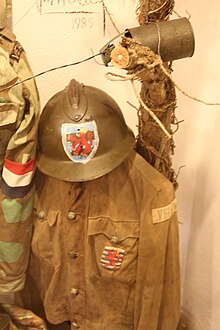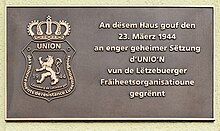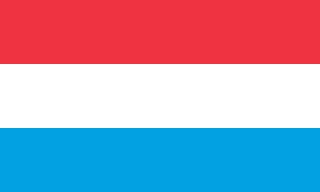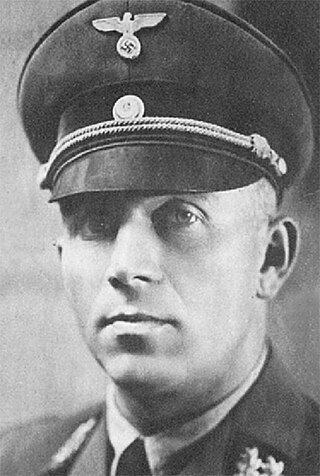Historical development
Overview
People who actively resisted the German occupation in Luxembourg were only a small minority (just like collaborators). [1] The relationship between them and the wider population can be described as "symbiotic". The resistors, without the support of the population, would have struggled to operate, and without the Resistance's activity, the population might have succumbed to the German occupants' propaganda. [1]
Early beginnings: spontaneous protest
German troops invaded the country on the morning of 10 May 1940 as part of the wider invasion of the Low Countries and France. By the end of the day, Luxembourg was almost entirely occupied. The Grand Duchess and the government politicians immediately went into exile. With no moves of a French counter-attack nor any news at all from the government, there was a general sense of abandonment in the population. [2] However, their attitude towards the occupiers was robustly hostile from the beginning. [2] Without real means of defence, they had to bend to the Germans' wishes, but little by little acts of sabotage and demonstrations of anti-Nazi sentiment appeared. [2] Phone lines would be cut here and there; in many villages, discussions with the German soldiers turned into brawls from which the Germans had to flee. [2] The consequences of these actions came soon. From late May, the first Luxembourgers were judged by military tribunals for physically fighting with German soldiers or causing offence to the Wehrmacht or Adolf Hitler. [2]
In August, the Gauleiter Gustav Simon arrived in Luxembourg as Chef der Zivilverwaltung, taking over from the military administration. He implemented a "Germanisation" policy to prepare Luxembourg for complete annexation into Germany, which heightened Luxembourgish hostility towards the new regime. [2] The "Spengelskrich" (Luxembourgish; "war of the pins") was one of the first episodes of this spontaneous public resistance. [2] From 14 August 1940, many Luxembourgers publicly wore pins showing the Luxembourgish red lion, which they had worn recently in 1939 for the centenary festivities of Luxembourgish independence. [2] Activists of the pro-German collaborationist Volksdeutsche Bewegung tried to tear off these pins, and fights would break out. [2] The Gestapo intervened against the pin-wearers, calling them "provocateurs". [2] Nevertheless, the wearing of patriotic symbols continued throughout the occupation as a sign of defiance and many young people found themselves in front of special tribunals, accused of anti-German agitation. [2]
The demolition of the Gëlle Fra monument in October 1940 saw protests from many Luxembourgers. [2] The Gestapo arrested around 50 young people who were taken to the Villa Pauly, the Gestapo's headquarters in Luxembourg. [2] Until autumn 1940, then, Luxembourgers protested in a spontaneous and disorganised fashion against the German occupation and annexationist measures.
Organised groups

In parallel with individual acts of protest, the summer of 1940 saw the first attempts to organise resistance to the German occupation on a more permanent level. The youth played a decisive role in this, both in schools as well as among young workers. [1] Here, attachment to the idea of an independent Luxembourg as well as antifascism were strong motivators. [1]
From August, the heads of the Catholic Scouts in the south of the country met in Esch-sur-Alzette and decided to engage in resistance against the Germans. Similar meetings later took place in Luxembourg city, Diekirch and Wiltz. When the occupiers banned the Scout movement in Luxembourg, the organisation continued to exist underground, under the name Lëtzebuerger Scouten an der Resistenz (LS). [2]
In late September, Raymond Petit, a student at the Lycée of Echternach, founded the group LPL, the Lëtzebuerger Patriote-Liga. [2] Similarly, at the Lycée of Diekirch, Camille Sutor founded the Trei Lëtzeburger Studenten (TLS). [2] The Lëtzebuerger Legioun (LL) was founded on 27 October 1940 by Aloyse Raths, a student at the École normale, in his native village of Bissen. [2] In November 1940 a retired customs officer, Alphonse Rodesch, founded a second movement with the name LPL in Clervaux, referring to the World War I movement of that name. [2] In December 1940, Hubert Glesener, Eduard Heyardt and Pierre Fonck formed the LFB (Lëtzebuerger Fräiheets-Bewegong) in Rumelange: this organisation included Catholics, liberals and communists. [2]
By the summer of 1941 other movements were formed around the country, especially in the south and south-west: in Bascharage, Albert Meyers founded the Lëtzebuerger Roude Léif (LRL); in Differdange, Tétange and Rumelange the LFK (Lëtzebuerger Fräiheets-Kämpfer) was formed. [2] In Schifflange left-wing activists formed the "ALWERAJE", the only group willing to work together with the illegal Communist Party of Luxembourg. [1] [2] In Differdange, Josy Goerres created the Service de Renseignements et d’ Action des Patriotes Indépendants Luxembourgeois ("SRA-Pi-Men"). [1] [2] Another LFB group, the Lëtzebuerger Fräiheets- Bond, was formed in Dudelange. [2]
All these groups quickly entered into contact with one another, and several mergers soon took place. First, the TLS merged with the LL, then in June 1941, the LS and LL merged to form the LVL (Lëtzebuerger Volleks-Légioun), the largest Resistance group. [1] [2] On the other hand, an attempt at cooperation between the LFK and LFB in Rumelange ended in betrayal and hundreds of arrests. [2] Further arrests from November 1941 onwards decimated various Resistance groups, with the result that the LVL, the LPL and the LRL became the most substantial remaining organisations, attracting the surviving members of the defunct groups. [2] [3]
The only political party to continue to operate underground was the Communist Party of Luxembourg (KPL). [3] However, in August 1942 a police raid weakened Communist resistance, and the schoolteacher François Frisch, who was close to the Communist politician Dominique Urbany, founded a new movement, the ALEF (the Aktiv Lëtzebuerger Eenheetsfront géint de Faschismus). [3]

From 1943 at the latest, Resistance members recognised a need to unify the various organisations. [3] Already in October 1941, attempts had been made to coordinate the different groups' activities against the introduction of mandatory military service. [3] But it was not until after the wave of arrests in 1943 and the executions in February 1944 that the Unio'n vun de Letzeburger Freihétsorganisatio'nen was created on 23 March 1944, uniting the LPL, LRL, and LVL, after long and difficult negotiations. [3] [4] Although the LFB was also a part of these negotiations, it initially chose not to join the Unio'n, but would do so later on 1 September 1944. [3] [4] The Unio'n was headed by a central committee composed of two delegates from each of the 3 member organisations. [3]
Structure
Christian, liberal and patriotic groups (NS-designation: "Reaktion"):
Unio'n vun de Lëtzebuerger Fräiheetsorganisatiounen (Unio'n), 1944: [4]
- Lëtzeburger Patriote Liga (LPL), 1940
- Lëtzebuerger Legio'n (LL), 1940 → Letzeburger Volleks-Legio'n (LVL), 1941
- Trei Lëtzeburger Studenten (TLS), 1941
- Lëtzebuerger Scouten ≈ Lëtzeburger Freihéts-Kämpfer (LFK), 1940
- Lëtzeburger Ro'de Lé'w, 1941
- Lëtzeburger Freihéts-Bond ≈ Lëtzeburger Freihéts-Bewegong (LFB), 1940
- Patriotes Indépendants ("PI-Men"), 1940
Communist and international-socialist groups (NS-designation: "Rotfront"):
- Aktiv Letzeburger Enhétsfront ge'nt de Faschismus (ALEF), 1940
- Kommunistesche Kampfgrupp Schëffleng ("Alweraje"), 1941
After the war, the LPPD was formed, an umbrella group of the Resistance.
Multiple "Resistances"
"The Resistance" never existed as a unified entity; instead resistance was constituted into several separate Resistance organisations. The war did not unify the country any more than it had been previously, although more people became conscious of their national identity, and several collective victories, such as the strike of 1942 and the failed referendum of 1941 proved that cooperation was possible. [5] The Resistance was above all a regional phenomenon: each organisation had its geographical base, and none operated across the whole country. [6] While the different Resistance entities were united in their common goals of freeing the country from Nazi German occupation and safeguarding Luxembourgish independence, they had different forms of organisation, ways of working, and political visions for a post-war Luxembourg. [7]
Politically, two tendencies in the Resistance can be distinguished, one left-wing (including the Communist Party of Luxembourg) and one right-wing (LVL, LPL Clervaux, Unio'n). [5] There were also organisations that had no particular political programme, which mostly occupied themselves with practical matters; as well as a large number of resistants who were not affiliated to any organisation.
The Communist Party of Luxembourg (KPL) hesitated for a long time before taking up hostilities against the German occupier, due to its loyalty to the Soviet Union, which itself was not at war with Germany until June 1941. From May 1942, the KPL advocated the policy of the popular front against the fascists, but also continued to have other political goals in mind, and saw the social democrats as a political rival. The Communists saw the fight against the German occupiers as merely the first step towards a radical change of the social and political landscape.
The KPL was not the only organisation whose political goals kept it from cooperating with other groups. The admission policy of the LVL stated that membership was forbidden to anyone who was a communist or a "drunkard". [5] The right-wing Resistance groups were generally to be found in the north, based among rural communities. Religious motivations were a significant factor for them, and they followed a "Marian cult" devoted to Grand Duchess Charlotte. At the same time, the LVL adopted the anti-Semitism of the Nazi occupiers, and the Unio'n called for a Lebensraum (living space) for the Luxembourgish people in terms very similar to those found in Mein Kampf .
For the organised Resistance, the prime motivating factor appears to have been not a desire for liberty or a democratic ideal, but nationalism, albeit influenced by socialism for those on the left, or by anti-parliamentary corporatism on the right. [5] If there was one characteristic which was common to all Resistance movements, then, whether on the left or the right, it was this nationalism. This becomes apparent in the Resistance organisations' interpretation of history: an emphasis on the "Luxembourgish" emperors of the Holy Roman Empire, a glorification of John the Blind and the participants in the peasant war known as the Kleppelkrich , attacks on the "foreign domination" from 1443 to 1839. [8]











